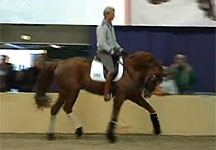Pressure is mounting on the FEI to look again at the practice of riding horses in a very deep and round neck frame known as hyperflexion or rollkur.
This is in response to a video circulating the internet showing Swedish team dressage rider Patrik Kittel schooling his horse in hyperflexion at Odense, Denmark, 18 October.
At the Global Dressage Forum on Monday, FEI executive sports director David Holmes announced the FEI’s decision to investigate, saying: “The FEI’s main concern has always been and will always be the welfare of the horse. We are taking the issues raised in the video and in the comments made by other Youtube viewers very seriously and have opened an investigation. The conclusions of this investigation will be made public.”
However, BHS chairman Patrick Print has since written to HRH Princess Haya requesting the FEI launch a second investigation into the practise of hyperflexion.
Print’s letter reads: “The concerns so widely expressed are reasonable and therefore deserving of an urgent two-part investigation: first, an inquiry into the treatment of this particular horse on this particular occasion; and, second, a broader inquiry into the ethics and consequences of hyperflexion. In this second aspect The British Horse Society stands ready to assist the FEI in any way it can.”
Forums are rife with angered comment on the topic and several facebook groups have been set up in condemnation of rollkur.
The Classical Riding Club have also written to the FEI and are urging all members to sign their petition to the FEI to ban all hyperflexion in competition.
In 2006, the FEI investigated hyperflexion. Their most recent statement on the subject in 2008 reads: “The FEI held a successful seminar on Hyperflexion in 2006. There has been no change in the scientific evidence since that review. There are no known clinical side effects specifically arising from the use of hyperflexion. However, there are concerns for the horses’ well-being if the technique is not practised correctly. The FEI does not permit excessive or prolonged hyperflexion in any equestrian sport, and has a strict stewarding program to protect the performance horse in all disciplines.”
See Horse & Hound 5 November issue for latest developments on this issue and views from those within the sport including Sweden’s Patrik Kittel.

